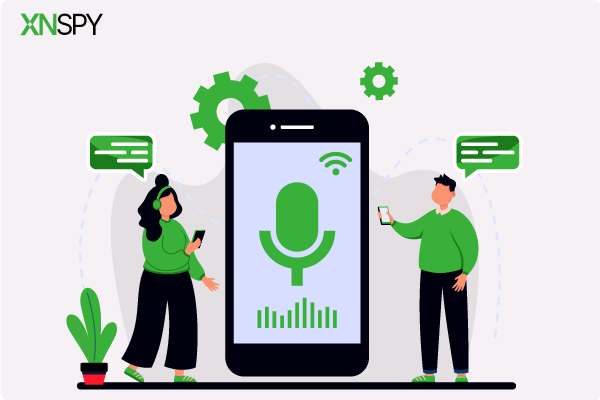The complete monitoring experience for your phone
Get XNSPY and start tracking calls, texts, multimedia, locations and more on any phone!
Get Started Now Live DemoIt is common today to see your kids glued to digital devices, mostly their smartphones and tablets. With busy routines occupying most of our time, we rarely consider the possibility that the children’s excessive digital use might be growing into a digital addiction.
But one of the most common questions parents ask on social media forums and Facebook groups is ‘how to stop their kid from excessively using their phones.’
What is Digital Addiction?
The impulse control disorder that involves excessive use or harmful dependence on digital devices, technologies, and platforms is called digital addiction.
A massive percentage of people across the world are not only practicing but also susceptible to developing this addiction. However, kids are becoming digital dependent faster than the speed of knots because they tend to be more tech-savvy and have more time on their hands.
Furthermore, Pew Research states that almost 95% of teens have access to a smartphone, and 45% say they are constantly online, almost half the population of kids.
There are multiple avenues of online/digital addiction that children use. Some of these include:
Social Media
It is no surprise that social media apps have become part of kids’ daily lives. They use it to flaunt their best version and get an update on all the latest news and trends. Many kids experience FOMO (Fear of Missing Out) on any important news, gossip, trend, or event and actively engage with emerging trends.
Moreover, the apps are designed purposefully to keep the kids engaged and scroll endlessly through their news feeds and other people’s profiles. Most kids develop an uncanny obsession with likes, retweets, notifications, and growing lists of followers. It is why 54% of teens say it is hard to give up social media.
Gaming
At least 53% of households in the US own a gaming console and 30% plan on buying one. This stat reveals that playing video games is common in every house and starts from a young age.
Apart from gaming consoles, hundreds of games are available on Android and iOS platforms that kids can easily access and play. There are not only several categories of games, but kids develop a constant urge to keep on playing without caring about time or other commitments.
Streaming
Children easily get hooked on visual content, which is why YouTube is the most popular social media platform among teens, and YouTube Kids is popular with the younger audience. Not only does the platform provide videos on nearly every subject, but it also has algorithms that keep young kids hooked on clicking related videos.
Apart from YouTube, teens are growing addicted to streaming networks such as Hulu, Disney+, Netflix, and Amazon Prime. Some platforms, like Twitch, even allow kids to watch their favorite games if they are not playing them.
Is Screen Time Addiction Real?
The term digital addiction is speculated within the fields of psychiatry and psychology. This is because some experts believe that excessive use of digital technology follows similar patterns to that of substance abuse.
While some experts state that frequent use of technology is essential in today’s society. They say any misuse may be due to other underlying issues, and so cannot be termed as addiction.
The balanced opinion of experts does not undermine the psychological and behavioral impacts of digital dependence on children. Several studies state that constantly using social media for more than 3 hours can increase risks of anxiety, depression, ADHD, body image issues, and low self-esteem among kids.
The likes, shares, and comments surge the dopamine level and induce a feeling of high that is similar to a person who gambles and uses drugs.
Children who are overindulgent in gaming and use social media at a tender age are more likely to develop future mental health disorders and addictive behaviors.
Therefore, parents need to monitor whether their child spends too much time on screens and look for noticeable signs and symptoms.
The Signs of Digital Addiction
Kids, particularly teens, tend to use digital technology for both educational and entertainment purposes. This can sometimes make it difficult for parents to determine whether it’s overuse or addiction. However, noticing certain tell-tale signs can help you understand their behavior more clearly.
Low Feelings of Excitement in Other Activities
Children spending less time with toys, books, and sports is a common predicament that parents of every house complain about. The kids, instead, want to play a video game on a smartphone or watch their favorite cartoon on a tablet.
If you involve them in other playful activities, the kids respond by saying that it’s boring or childish. Many kids may even cut other activities to spend more time on their smartphones or gaming consoles.
Less time Socializing with Family and Friends
Smart devices allow teens to develop digital interactions through social media and online gaming. However, simultaneously, they can also tend to limit their physical communication with not only family and friends but also their peers and neighborhood kids. If this behavior continues for a long time, the child is likely to develop social problems.
You often see your child watching a video or playing a game at the dinner table. The teen might also skip hanging out with friends and instead spend time on the gaming console.
Lifestyle and Behavioral Changes
Your child can spend significant hours playing video games, surfing the internet, and interacting on social media. All this activity will considerably affect their lifestyle and behavior if left unchecked.
The child will experience trouble sleeping, become picky about their appetite, lose concentration quickly, not perform adequately at school, and even neglect personal care.
Withdrawal Signs
One of the clear signs of digital addiction is how your child reacts when you close the TV for bedtime or take away a mobile phone for family time. Some of the common screen time withdrawal signs to notice are frustration, irritability, mood swings, anxiety, and refusal to eat or sleep.
However, depending on age, kids may exhibit varying degrees of these signs.
Preoccupies Their Thoughts
Even if the child is not playing a game or watching videos from their favorite content creators but endlessly talking about it, this shows their level of addiction. You may be discussing some other subjects, but the kids will somehow try to relate it to a particular game, video, or any digital app they commonly use.
Steps to Curb Digital Usage Among Kids
Noticing the signs is the easy part of knowing that the child is overly engrossed with a digital device. However, the critical part is devising a strategy that can help you curb this habit of the kids before it leaves an indelible effect on their lives.
Discuss Digital Use
It is improbable to keep your child away from digital technology for long. Sooner or later, you will have to accept that kids will play games on a console, talk to their friends through a smartphone, and stream videos online.
It is best to discuss digital use with your kids openly and set clear guidelines. This may include designating screen time and restrictions on the use of particular apps or video games.
Encourage discussion on responsible device use and also make the consequences of extravagant screen time obvious.
Limit Screen Access
You must control kids’ access to smartphones, televisions, and gaming consoles. It is necessary to exhibit control, particularly when kids should be prioritizing other tasks, such as studying for their school examinations.
One key thing is keeping cell phones, tablets, and consoles out of kids’ rooms to avoid using them late at night. You can even install a parental control app to set and monitor their screen time.
Promote Healthy Activities
Take time from your busy routines and introduce the child to healthier activities. Allow them to participate in hobbies and activities that give them a sense of purpose and satisfaction.
These include outdoor physical sports activity, indoor creative pursuits, or even social interactions with neighbors. You can even get them a pet cat or ask them to take the dog for a walk daily.
Install a Monitoring App
Nowadays, kids revert to digital devices out of habit and curiosity, no matter how hard you make them understand its adverse effects. With an active lifestyle, keeping track of their digital use is rather challenging. Furthermore, you worry that their increasing screen time might land them in trouble.
You can use Google Family Link or Apple ScreenTime, but these have limited options, and kids today can easily dodge these restrictions. Conversely, XNSPY is best for monitoring the child’s digital device usage, whether it’s a smartphone or tablet. You can view all the apps installed on their device and accurately check the time they spend on each app.
Whether online or offline, XNSPY helps you remotely gain insights into how the child engages on social media, the messages they exchange on IM apps, and the places they visit. The screen recording and screenshots feature will help determine usage patterns and identify any dangers. Watchlist alerts will instantly notify you of issues such as bullying, sexting, and abuse.
The remote control option further allows you to limit access and even block certain apps and websites for the kids.
Seek Professional Help
If the signs of digital addiction persist or become more severe even after trying out the solutions, you need to seek professional help. Consider taking the child to a medical health professional who deals with behavioral and addictive symptoms among kids.
These experts handle such cases frequently and devise pertinent strategies depending on the extent of addiction signs among kids.
Closing Thoughts
Like most parents, you wish to achieve the ultimate balance in allowing kids digital freedom while also keeping a check on their activities.
However, the balance may look and work differently for different children. You first need to see and note down the number of digital devices the child has access to. Next, you must watch out for early signs of addiction and address them.
The behavior and lifestyle changes are clear signs to notice and those that require immediate attention. You can talk to your child at length about their tech usage, which is far from being healthy, and set screen time limits.
However, installing XNSPY is essential to monitor their activity and ensure that the child only spends a little bit of time on their screens and falls into other online dangers.


